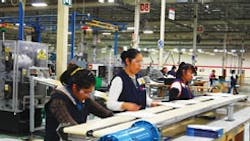There’s probably enough open space at the Avery Dennison Office Products de Mexico plant in Tijuana to play a football game. Upon entering the plant, actual manufacturing activity seems so distant a pair of binoculars might be necessary. But plant leaders say the empty area is a sign of progress.
That’s because through value stream mapping and lean initiatives, the organization was able to free 310,000 square feet of space in the 524,000-square-foot plant over a six-year period. This year the effort is expected to bring the plant’s share of Avery Dennison’s North American office products production to 66% from just 15% in 2004.
The plant received a boost in 2008 when the company’s Fontana, Calif., distribution center closed and relocated to the Tijuana operations. The plant consolidated what occupied 400,000 square feet in Fontana into 230,000 square feet, says Key Fujimura, the plant’s continuous improvement leader. Then, in October 2010 the plant received more good news when Avery Dennison announced it would move its Ciudad Juarez printed media and dividers operations to Tijuana. The transition is expected to be completed by the end of this year.
The plant first began releasing space in 2004. At the time, the facility was cluttered with machines, inventory pallets and material, says plant manager Arnoldo Pena. Plant leaders began opening space by eliminating inefficient older equipment and improving existing machines, moving to continuous-flow production from batch processing and reconfiguring lines into U-shaped cells. In 2009, the area where the plant produces three-ringed binders cut its footprint in half with a reconfigured cell design, Pena says.
The plant takes part in five-day, high-level value stream mapping events called SWOT (strengths, weaknesses, opportunities and threats). The events comprise cross-functional work teams from different departments that create the operation’s roadmap for future success, or “shikumi.” The shikumis are then used to develop an A3 plan, or business strategy for the following year. “Everybody has input into what went wrong and what went right,” says Hector Marquez, operations manager. “So this is a process that’s been dynamic and adjusts to current needs.”
On the plant floor, one of the more innovative employee-generated ideas came from line worker Azucena Robles, who operates the machines that apply labels to the company’s famous Glue Stick brand. Previously, when the feeder ran out of labels, Robles would have to stop the machine for five minutes as many as 30 times per day to refill the labels to prevent blank Glue Stick rolls from moving down the line. Robles suggested that the plant install a machine that shoots compressed air to push the blank rolls off the line into a box, saving the line from frequent delays.
Such a high level of employee involvement should come in handy this fall when product complexity is expected to double and the number of stock-keeping units jumps to 4,000 from 1,800.
Jonathan Katz is managing editor of MH&L’s sister publication, IndustryWeek. Learn more about the IndustryWeek Best Plants program at www.iwbestplants.com.
